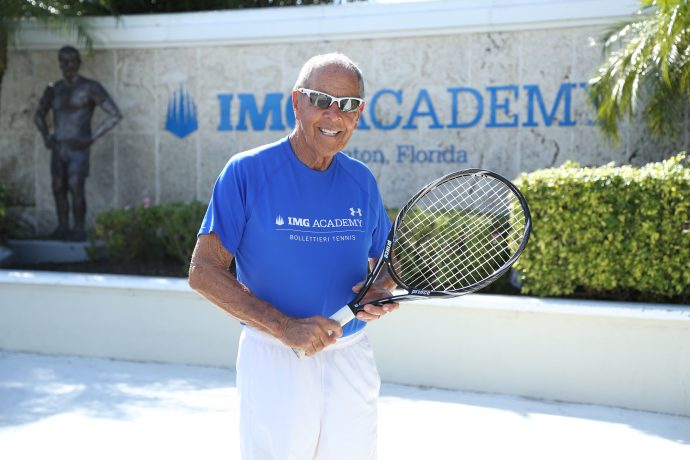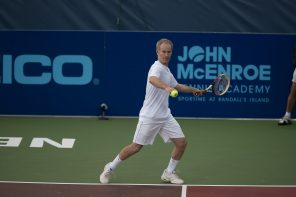Legendary tennis coach Nick Bollettieri has had 10 No. 1-ranked players, including Monica Seles and Andre Agassi. So who better to turn to when we want a little sage court talk? The Pelham native is as busy as ever, coaching in the IMG Academy Bollettieri Tennis Program in Bradenton, Fla. – “that’s where I’ll remain,” he stresses – and promoting his new book, “Changing the Game” (New Chapter Publisher, $26.95). WAG caught up with him on his return from Wimbledon, where he did commentary for the BBC early in the tournament, and from Newport, R.I. where he was among those enshrined in the International Tennis Hall of Fame on July 12.
Looking into your crystal ball, who do you like this year to win the US Open men’s and women’s titles and why?
“There have been many surprises both at the French and Wimbledon. Chief among them are Serena (Williams’) early exit from each tournament and the emergence of several young men and women players who made strong statements in those events. If Serena is 100 percent, I’d have to put her as the favorite. If she’s not 100 percent, I’d have to put Maria (Sharapova) as the favorite. On the men’s side, each of the big four are the favorites (Wimbledon champ Novak Djokovic, Wimbledon finalist Roger Federer, French Open champ Rafael Nadal and former Wimbledon and US Open champ Andy Murray). On both the men’s and women’s sides, however, I’m very interested to see if the veterans can keep their places or if the young players will be able to unseat them as they began to do at the French and Wimbledon.”
Who are the up and coming stars we should be watching?
“On the men’s side it’s (Wimbledon semifinalist Milos) Raonic, (Wimbledon semifinalist Grigor) Dimitrov, (Kei) Nishikori, and (Nadal slayer) Nick Kyrgios. On the women’s side it’s (French Open and Wimbledon semifinalist Simona) Halep, (Wimbledon finalist Eugenie) Bouchard and Sloane Stephens.”
What about the Americans: Anyone exciting on the horizon?
“At this time the men’s side is truly struggling. On the women’s side, however, we do have several promising ladies coming up. These include Sloane Stephens, Madison Keys, Victoria Duval and Lauren Davis.”
Why is the United States no longer a tennis superpower?
“In the ’60s, ’70s, ’80s and ’90s, there were only a handful of countries where tennis was popular and played. Today the whole world plays tennis. In many of these countries, tennis is the second or third most popular sport and the best athletes are attracted to it. In the U.S. however, most of our best athletes are going into basketball, football and now soccer, which are all very inexpensive for parents. Tennis, on the other hand, is expensive for parents.”
We talked about tennis becoming a power game with players slugging it out from the baseline. Has that rendered the game one-dimensional?
“The trend is definitely going that way. However, to be the best on the ATP or WTA tours, players must learn an all-court game where they can come in when given the opportunity. To reverse the trend of one-dimensional players, there will have to be a few players who have success coming in a lot. The tours may also have to place more importance on that style of play by speeding up some courts and also promoting a fall indoor season with fast courts.”
We hear a good deal of talk about the GOAT (Greatest of All Time). Recently, Andre Agassi stirred up a hornet’s nest by saying he thought Rafael Nadal was the GOAT. Who in your opinion are the greatest male and female players to date?
“I do not disagree with Andre. Rafa may very well be the GOAT, but I don’t think it’s been established as of today. Rafa is definitely the GOAT on clay. A few more Grand Slams on other surfaces will give more strength to Rafa being the GOAT. When you go to the ladies, you must include Serena Williams, Martina Navratilova, Steffi Graf, Chris Evert, Monica Seles, Billie Jean King and Margaret Court.”
Tennis is probably the most individualistic of sports. What’s more important in tennis – talent or temperament?
“Talent alone will not make you a champion. Mental strength, the desire to win and total commitment to the process are equally important. A champion has the right combination of all of these. I also judge a champion by the way he/she can find a way to win in the face of all variations of adversity.”
Your book has been out a couple of months now. How’s it doing?
“‘Changing the Game’ has had wonderful reviews and is picking up steam. It’s the story of a guy who grew up on the wrong side of the (tennis) tracks with only his dreams and through determination and with the support of great friends was able to fulfill some of his dreams. It’s an honest look at my ups and my downs, my successes and failures, and what it took for me to do what I’ve been able to do in the sport. To me, that’s why people should read the book. It’s about pursuing your dreams. Autographed copies can be purchased on my website (bollettierithebook.com). It’s also being sold in bookstores.”
You were so emotional as Monica Seles introduced you as an inductee in the International Tennis Hall of Fame during World Tennis Day at Madison Square Garden March 3. Your thoughts on the July 12 induction.
“The International Tennis Hall of Fame weekend was an extraordinary event. I was humbled and at a loss for words, not something I’m used to. I am extremely grateful for the honor and to all of my family, friends, players, and coaches who supported me at the event and throughout the years. My parents would be very proud.”
If you could play doubles with anyone in the world and throughout history, who would it be?
“I’m thinking of the great doubles teams that impacted me – Mac (John McEnroe) and (Peter) Fleming, the Woodies (Todd Woodbridge and Mark Woodforde), the Bryans (Bob and Mike), (Brian) Gottfried and (Raúl) Ramírez, (Max) Mirnyi and (Daniel) Nestor, and (Leander) Paes and (Mahesh) Bhupathi are some of my favorites. In terms of one player in history I would liked to have had the chance to play doubles with, I’m taking the Fifth.”





